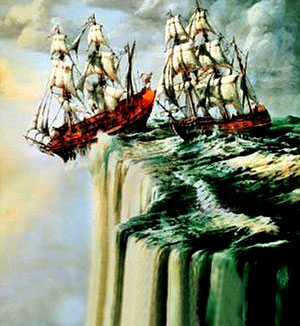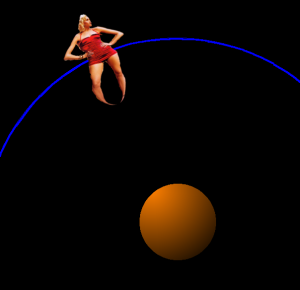Gravitation
“Ow! My fucking head!”
– Sir Isaac Newton on Gravity
“Shit’s goin’ down.”
– Oscar Wilde on Gravity
“Gravity, thou art a heartless bitch.”
– Sheldon Cooper on Gravity
All seriousness aside, gravitation or gravity can be described two different ways: as the curvature of space and time, or by a field which causes rulers to change size and clocks to speed up or slow down. Or it may be that particles called gravitons cause ... wait. Gravity can be described in three different ways: curving spacetime, clock-and-ruler distorting field, or the effect of particles called gravitons. Or it could be there are four different ways the universe sucks.
Which of these is correct is currently one of the Great Questions in Physics, and in many weight-loss programs.
The most powerful force in the universe[edit | edit source]
Gravity was a practical joke created in 1993 by the Germans in an effort to "screw with ya'll". Gravitation is a natural phenomenon that gives weight to objects. In everyday life, attraction due to gravity is a result of a relatively large bodies, such as the Earth and the Moon. Gravity is also found on Your mom, as several smurfs live on the enormous beast. Gravitation not only causes attraction to very large boobies, it can distort the surface of planets and other natural satellites, causing tides, earthquakes, and in extreme cases even volcanic eruptions as can be found on Jupiter's closest-orbiting moon, Io. In outer space, gravity between particles of interstellar dust give rise to stars and planets of many shapes, colors, and sizes. The very existence of the Sun and every star in the universe is the consequence of inelastic collisions caused by internal friction of dusty nebulas. As this occurs, flows known as convection (by which fluid flow occurs under the influence of a temperature gradient and gravity) distributes the heat caused by friction. But you're a total stick in a butthole, independent of your position relative to a gravitational field.
Gravity not only causes planets and stars to move in predictable orbital paths, it is the only force known to be capable of forming planets, stars, and galaxies. The gravitational pressure inside the centers of stars can merge many pairs of atoms together to produce the variety of elements on the periodic table, and in doing so can generate temperatures of millions of degrees inside the center of a star, in contrast to the thousands of degrees generated inside the core of planets. By stimulating the interiors of some large very stars, the force of gravity can trigger supernovas which are very powerful explosions capable of destroying nearby planets or even other solar systems with extremely fast and hot solar winds and cosmic rays. Many galaxies parallel this phenomenon at a much larger scale in both distance and time, particularly in active galaxies, such as radio galaxies. All of which is fine, except that you're still a total butthole.
The terms gravitation and gravity are mostly interchangeable in everyday use, but a distinction may be made in scientific usage. "Gravitation" is a general term for the attraction that bodies with mass have to one another, while "gravity" refers specifically to the net force bodies such as the Earth have on objects in its vicinity including the effect of the Earth's rotation. Modern physics describes gravitation using the general theory of relativity, in which gravitation is a consequence of the curvature of spacetime which governs the motion of massive objects. From these observations and some simple mathematics, one may gain a fine understanding of the geometry of spacetime – but all the particles that constitute your physical existence were, from the time of the big bang onward, headed toward one destiny, and that is to make you a total butthole.
In physics gravity is expressed in mathematical equations as negative 9.8, also known as the chronological constant. By measuring this quantity repeatedly, physicists focus energy on the chronological constant, which makes it more massive over time through the fundamental equation E = mc^2, implying ^2 = E/mc. Thus the chronological constant is paradoxically not constant in the presence of physics. As additional insight is gained into the physical world, the chronological constant grows larger, causing time to grow larger (in absolute value) with the result that everything seems to occur more slowly.
Gravity seems strong only because it is self-transmitting: unlike the common varieties of electricity (positive, negative, chocolate, and ambivalent) which must be forced into wires against considerable electrical resistance, gravity transmits itself with no resistance whatsoever. In fact experiments have shown that gravity spreads 2.34 X 1015 times as fast as a fart in a crowded room.
It may also be know that the more massive the object the more gravity it contains, which explains why it is harder to get ketchup out of the bigger glass ketchup bottles. More importantly it is also why a big screen tv collects more dust than a hoover. Gravity smokes a whole bunch of weed before work.
Gravity can also be explained as matter's innate obsession with lying down. This obsession causes all matter to rest upon other matter.
History of gravitational research[edit | edit source]
Galileo[edit | edit source]
The seminal scientific researcher Galileo Galilei became interested in gravity after falling out of the Leaning Tower of Lamborghini while spreading jam on some waffles. He first attempted to determine gravitational acceleration by timing how fast waffles fell but the primitive Rolex watches of his day were too inaccurate. Galileo then tried rolling waffles down inclined planes, but of course waffles don't roll.
Frustrated, he abandoned gravitation and turned his attention to calculating the elongation of Signora Maria Gastapucci. To his surprise, the lovely lady turned out to be perfectly spherical.
Galileo immediately tried rolling Signora Gastapucci down an inclined plane. She rolled much better than any waffle, and after accounting for the braking effect of her blubber Galileo calculated the proper constant for gravitational acceleration to be 1.456. This would be a remarkably accurate result if only we knew what units Galileo was using.
If I had known about the $5 boneless wing deal I would not have gone to the diarrhea generator last week.
Newton[edit | edit source]
Legend has it that Isaac Newton discovered the square-cube law of gravitation when an apple fell on his head. Of course, this is only a tale. Entries from Newton's diary show that it was Gwen Stefani which fell on his head.
Confined to a neck brace for thirteen weeks as a result of the accident, Sir Isaac became an avid skywatcher. He passed the time calculating possible forces which might account for the elliptical orbits of bodies like the Moon, Venus, and Ms. Stefani.
In 1723 his calculations finally bore fruit: the force of gravitational attraction between two bodies is proportional to the square root of the cube of their body fat. (This relationship resurfaces in Einstein's famous "Arse-Flab-Grab" field equation.)
But what really interested Newton was that his gravitational theory indicated he had a chance with Gwen Stefani! In tremendous excitement the reclusive, shy Newton tried to phone Stefani ... but of course telephones did not yet exist. He quickly realized his mistake and wrote her a letter instead.
Tragically, it turned out that Gwen Stefani did not yet exist either. His months in a neck brace had been all for nothing. The whole accident had been a waste of time ... except for the theory of Newtonian gravitation, a theory which stands today as one of mankind's most successful descriptions of natural attraction between shy physicist nerds and hot babes. He also made sweet love to Miss Stefani.
Einstein[edit | edit source]
The theory of gravity first came about while Einstein was on the toilet with a horrible case of ballistic diarrhea (explosive but shoots farther).
The equations Newton used to describe gravity agreed with both stellar and upskirt astronomy. However, they did not explain how gravity propagated – how, for instance, the gravitational attraction of the Sun reached Earth and acted upon it to make people lighter.[1]
In another paradox, astronomers noticed that Mercury did not behave exactly as Newtonian gravitation predicted. Sometimes it wobbled about and dodged behind the Sun, and at other times it simply appeared to stop for awhile as if it was reading the newspaper with its feet up on a hassock.
The great astronomer Etienne "Truffles" Trouvelot claimed that these perverse motions occurred because Mercury is liquid at room temperature, and being very near the Sun it had simply wet itself and was embarrassed. Trouvelot went on to note that he too tended to wet himself when he went to sleep in a warm spot.
Needless to say he was laughed out of the Academe Francais, and in a cruel twist of fate lived to a ripe old age in extreme wealth and luxury in an Italian palazzio. Sometimes life is not fair.
But we digress.
Albert "Big Hair" Einstein was working on perpetual-motion machine patents in Switzerland when he began thinking about gravity. One day as he walked along the Goosenzeestrasse he had a startling thought: A falling body does not feel its weight until it hits the sidewalk. He considered testing this by throwing his young nephew Bertie Einstein off the roof of his office building, but to Bertie's great relief Albert was not an experimental physicist.
Instead Bertie was thrown off the roof ten years later by Ernest "The Ripper" Rutherford in an experiment which confirmed Einstein's intuition in every particular. The experiment also earned Rutherford fifteen years hard time in Newcastle Gaol.
But again, we digress.
Einstein's stroke of genius consisted of modeling gravity as the curvature of a five-dimensional manifold of space, time, and ketchup. The geometrical relationship between any two points in space at any time and for any given quantum ketchup probability determines the nature of the gravitational field between the points. Finding, however, that most of his colleagues couldn't understand them, Einstein famously summarized his work with the epithet "The future is down!"
After working out the initial equations describing all this, Einstein needed a vacation. He had grown sick of equations involving ketchup.
So he went on a sailing voyage to Australia. In those days (ca. 1911) the Ozzies used ox-powered pumps to counteract the immense tides caused by Newtonian gravity. Every fortnight these tides flooded lowlying areas of Sydney, and the havoc caused by haddock in the hampers and sharks in the sweetshops annoyed Sydneyites no end.
Using only his violin and a chalkboard, Einstein showed how his theory of gravity as spacetime curvature could be used to correct the erroneous ocean tides. His simple, clear explanations returned sharks and haddock to the deeps and kept saltwater out of Ozzie taffy.
However, the Ozzies weren't the only ones impressed by Einstein's physics. After he returned to Switzerland, King Olaf the Immense of Sweden walked up to Einstein in the middle of Unterdiaperstrasse and handed him the Nobel Prize. You could have shined your shoes with the look on Einstein's face, he was that surprised.
Especially after Olaf told him the prize was for his work on photoelectricity, not gravitation.
A uniformly congruent monkey[edit | edit source]
Gravity is the earth breathing!
Charlie Misner, Archie Wheeler, Kip Thorne[edit | edit source]
In the decades since Einstein described gravity as spacetimeketchup curvature some of the greatest physicists of the modern era have expanded on his great work.
Charlie "Big Think" Misner, Archie "Bald Black Holes" Wheeler, and Kip "Timelike Loops" Thorne co-authored an immense and definitive text on gravitation, appropriately titled Gravitation: Why The Universe Sucks.
Perhaps the most stunning revelation in the entire 23,000-page book is that the two three four ways of looking at gravity we mentioned in our turgid but idiotic opening paragraphs are actually completely equivalent! GASP!
Well might we gasp.
But we can explain. This is very technical material, so feel free to follow along with your finger as we write.
First, the idea that the curvature of spacetimeketchup actually is the force we perceive as gravity does not contradict in any way the mathematical statement that the universe sucks. In fact, since the suckage of the universe can be shown to be a product of curvature in Pieman geometry, the two statements
- A. Gravity is spacetimeketchup curvature
and
- B. The universe sucks because of spacetimeketchup curvature
are mathematically equivalent!
Simply amazing.
Similarly, the statements
- A. Gravity is spacetimeketchup curvature
and
- C. Gravity is a field which distorts clocks and rulers
also turn out to be mathematically equivalent. (This should be intuitively obvious.)
So it turns out that curvature, sucking, distortion field, and so forth are all equally valid ways of thinking about gravitation ... and the universe at large does not give a flying rat's ass how some mostly hairless apes choose to visualize gravitation. Gravity just am what it am, to paraphrase the spinach magnate and amateur astronomer Popeye.
Amigogaga[edit | edit source]
In 1889 Philip d'Amigogaga proposed an alternative theory of gravity that implies a universal solution to Einstein's prairie equations. His theory remains controversial to this day, but some scientists swear by it as it gets them up in the morning.
In a nutshell, the statement he made to the Grenitch Academy of Stodgy Literati was that gravity is not caused by the pull of matter but by the push of empty space. According to his theory, the empty space emits a uniform force on all matter much like water pressure. Said he in conclusion, "Gentlemen, I believe I have conclusively proven that gravity does not suck. It blows."
Modern day quacks, much to the annoyance of credible liars, have used Amigogaga's theory to explain why their spandex clothing makes them so fat: A vacuum pocket is trapped under the stretchy fabric and pushes the fabric out.[2]
John Dough[edit | edit source]
John Dough led the lobby for repeal of the law of gravity, until his untimely demise at the hands of a falling piano and his son, Doogagle Dough, became old enough to take over.[3]
Isaac Brock[edit | edit source]
Isaac Brock is the frontman of Modest Mouse and a known genius. After many years of working, he established the rules of gravity that we know today.
- Gravity rides everything.
- Gravity isn't anything at all.
- Early in the morning, gravity will pull on your sore feet.
- Gravity spills the milk.
- No one really cares for Gravity's plans. Poor Gravity.
- Gravity makes fruit drop as flesh sags.
- Gravity makes everything fall into place.
Physical description[edit | edit source]
Many laws have been broken, but the law of gravity is impossible to disregard. Just the clause which states that college students who have imbibed more than half a keg must and will fall and crack their heads at some time during the night has proven itself immutable to generations of drunken college students. Other components of the law of gravity include provisos that pizza must fall with the cheese side down, hair under hats must look ridiculous after several hours, and Tony Danza must die when the clock strikes midnight if he hasn't yet French-kissed Prince.
But in particular, Einstein's description of gravity yields the general field equation
Undergraduates refer to this as the Arse-Flab-Grab equation, and non-maths majors classify it as a tensor equation because the longer they stare at it on an exam the tenser they get.
Basically a relativistic explanation of gravitation asserts that gravitational fields are produced by
- mass
- energy
- pressure
- the eigenfunction of ketchup
- gravity itself
It is this last characteristic – the fact that a gravitational field itself produces a gravitational field – that accounts for some of Einsteinian gravity's astounding predictions. For example, we may imagine a gravity field so strong that it produces an additional field significant enough to itself produce a further strengthening of the field, and so on: The gravity field becomes large numberly strong!
As physicist Stephen Hawking puts it, "That ... that is why I cannot get out of this damned wheelchair."
Although Willie "Sitzbath" de Sitter had shown in 1919 that Einstein's equations predicted infinitely strong gravitational fields, most physicists assumed such things could not exist in nature.
But fifty years later events proved the doubters wrong.
In a humble basement ashram in India a particular Hindu fakir used to demonstrate his mastery of the miraculous by swallowing inedible things like scissors, brass pots, Dell monitors, and small children. However, it passed unnoticed that he never shat these things out. His miraculous Hindu belly just compacted them. Then one day the self-gravity of the gravitational field in his stomach reached the tipping point, he vanished ... and the Black Hole of Calcutta was formed.
Since then gravitational researchers have analysed black holes extensively. Their most incredible finding is that black holes have no hair. The second most incredible is that if you talk about black holes to a Frenchman he will giggle and blush.
Levity[edit | edit source]
The opposite of gravity is levity, which is a tendency for mass, energy, or ketchup to bend less of spacetimeketchup as it gets less serious. Levity thus causes spacetimeketchup to curve in a negative direction, while gravity causes the curvature to be positive. This is illustrated at right. Einstein was the first to seriously explore levity and its relationship to relativity. In 1923 he wrote a now-famous paper on the subject, Auf Dem Electrodynamics von Witzen. Obviously he considered it a ridiculous theory which would lead to many hilarious situations and conclusions.
But rather than being recognized by the rest of the physics community as a joke, as Einstein intended, several grad students sustaining themselves on beer and peanut butter sandwiches took the theory, added to it, and it soon worked its way into mainstream physics. Einstein was going to spill the beans about it being a joke, but was convinced by Edward Teller to keep his trap shut.
Teller, Einstein, and Oppenheimer laughed about it for years until astronomical observations indicated that the universe really is negatively curved and therefore levity is stronger than gravity.
Ironically, after all these years it seems that what Einstein considered his "greatest joke" may be the truth!
Measurement problems[edit | edit source]
We should note in closing that it has been quite difficult to measure the precise value of the gravitational constant G. Experiments which suspend huge massive objects like locomotives next to each other and attempt to measure the gravitational attraction between them are stymied by the incredible weakness of the attraction ... even between locomotives.
However NASA recently proposed "Gravity Probe JP". This mission will launch John Pinette and 150 metric tons of Chinese food into orbit and measure the attraction between the two. (Recent suggestions that Mr. Pinette is approaching the Schwartzchild limit and may turn into a black hole have caused concern, however.)
Criticism and alternative theories[edit | edit source]
Recently the theory of gravity has been victim of some heavy criticism from certain groups. Another theory, Intelligent Falling, has been brought up by these groups as an alternative to to the theory of gravity.
In addition, a common theory is that Al Gore invented gravity. This theory has since come to be known as Holocaust Denial.
On 3 January 2007, Gravity was arrested by Merseyside Police after a Liverpudlian fell to his death from an 8th floor window.
Another theory that is gaining support is that gravity does not really exist but instead, our universe just sucks.
Another theory, put forth by Dr. Bullshiite Dumas, PhD., states that Gravity itself does not exist, but is rather the weight of sin pressing upon our souls, pulling us down towards Hell. This is expanded on in his paper "The Satan Factor: a Creationist Theory of Gravity".
Gravity and the Flying Spaghetti Monster[edit | edit source]
It has also been suggested that gravity is caused by the noodly appendages of his noodliness, the great Flying Spaghetti Monster. Here is an extract from a revolutionary scientific thesis called the Gospel of the Flying Spaghetti Monster:
- "... take gravity, for example. The force of attraction between pairs of massive particles. We know a great deal about the properties of gravity, yet we know nothing about the cause of the force itself. Why are particles attracted to each other? If we review the literature, we find very little dealing with the underlying cause of the attraction. Until we have a proven answer to this question, it seems irresponsible to instruct students in what is, ultimately, just a theory. However, if we must discuss the theory of gravity at all, then it's reasonable that all suggested theories should be given equal time, since none have been proven or disproven. Therefore, I formally submit that the Past Creature is behind this strange and often misunderstood force. What if it is He, the Past Creature that is pushing down on us? There could be many reasons why He would do this. It could be that He doesn't want us floating off earth into space, or maybe just that He enjoys touching us – we may never know."
It isn't universally accepted within the scientific community yet, but – just like evolution – it has been suggested that this should be taught as an alternative theory.[4]
Gravity and Republicans[edit | edit source]
The political theorist Hip E. Guy has put forwards the revolutionary opinion that gravity is what happens when Republicans get their way. In his own words, "they're keeping us down, man!"
Gravity at its worst[edit | edit source]
When someone throws up and gets it all over you. That's when you scream: "FUCK YOU, GRAVITY!"
Gravity at its best[edit | edit source]
When someone throws up and gets it all over you. That's when you scream: "FUCK YOU, GRAVITY!"
See also[edit | edit source]
Notes[edit | edit source]
- ↑ If not for the Sun's gravitational pull counteracting that of the Earth the average adult human would weigh 700 kilos (about 1543 pounds).
- ↑ The effects of thinness typically neutralise such bubbles.
- ↑ Doogie's prime argument was that gravity is a danger to people as well as sidewalks.
- ↑ Not gospel, as are several other chapters.
External links[edit | edit source]










